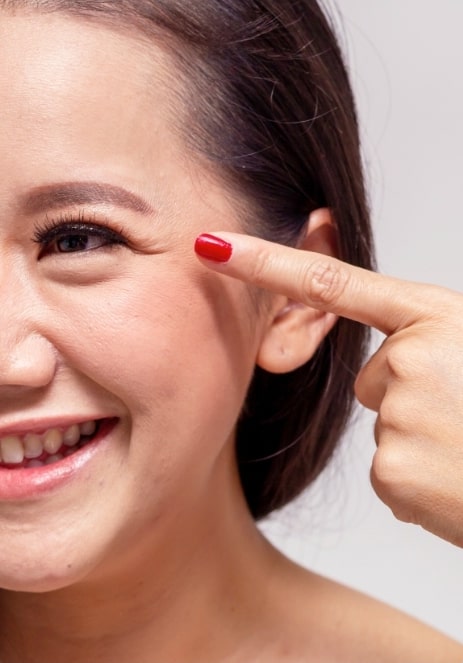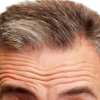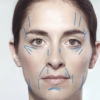
What Are Wrinkles?
Wrinkles in the skin (aka skin wrinkles, cutaneous wrinkles, rhytides) are a common sign of ageing and can be defined as ridges or furrows on the skin surface.
Causes are multi-factorial: a combination of intrinsic and extrinsic factors. Intrinsic factors are mostly the genetic background and cannot be altered. Extrinsic factors are sun exposure, smoking, alcohol, and nutrition – with sun (ultraviolet [UV] radiation) exposure being the main cause of extrinsic ageing.
Some studies show that UV radiation can be responsible for up to 80% of facial ageing (Uitto J,1997). These extrinsic causes can be reduced with effort, which can affect ageing signs such as wrinkles. Other factors that cause wrinkle formation include hormonal (especially oestrogen and androgens) influences and skin dryness.
Wrinkles and fine lines include signs of epidermal thinning, dermal-epidermal junction flattening, atrophy of the fat layer underneath the skin, skin laxity due to loss of collagen, and/or degradation of elastin. Accurately identifying all these signs can help on how to get rid of wrinkles.
For more information on skin laxity and the procedures available at AEON Medical, visit our skin laxity treatment page.
Causes of Wrinkles
Wrinkles can be caused by a range of issues.
- Sun damage: Exposure to ultraviolet (UV) rays from the sun is one of the biggest culprits when it comes to premature ageing. This UV radiation breaks down the collagen in your skin and affects the way your skin produces elastin. As the sun’s rays hit your skin, your body starts creating an enzyme called metalloproteinase. This impacts the way that your skin rebuilds and forms fibres, which can cause telltale sun damage, wrinkles, and also skin hyperpigmentation.
- Facial movements: The common lines that appear on your forehead and at the corner of your eyes are the results of everyday movements. Things you might not even realise you are doing like squinting or frowning create wrinkles over time.
- Smoking: When you smoke, your body produces less collagen. This causes wrinkles to form.
- Pollution: The smog particles and elements found in air pollution affect your skin every day as they break down collagen and affect your skin’s natural barrier.
- Ageing: As we get older, our skin is less able to hold onto moisture and heal itself.
Wrinkle Treatment Options
Treatment to remove wrinkles depends on the severity and type of wrinkles, as well as the patient’s skin type and medical history. While some wrinkles may not be completely eliminated, with proper treatment, the appearance of wrinkles can be significantly reduced. Treatments can also delay the onset of some wrinkles over time. It is important to seek professional advice from a qualified medical physician for proper assessment and to develop an effective treatment for wrinkles.
Common types of wrinkle removal treatment options include: (Disclaimer: the following list is not exhaustive, and results are variable depending on the individual)
Lifestyle Modifications
Reduce/Cease smoking and alcohol consumption.
Sun Exposure Related Habit Modification
Reduce/Cease tanning beds, ensure diligent and proper sunscreen application before sun exposure, and avoid excessive unnecessary sun exposure. Utilising hats, clothing, and shade when in the sun. This also helps avoid hyperpigmentation.
Routine Health Screening
To check for other health issues which may contribute to wrinkle formation.
Topical Cosmeceuticals
Mainly to provide skin hydration.
Botulinum Toxin A
Acts by relaxing the muscles that cause dynamic wrinkles, which, in turn, can cause static wrinkles.
Biostimulators
PDRN/Polynucleotides (PN), Hyaluronic Acid (HA) “skin boosters”, PLLA, PCL, Calcium Hydroxylapatite (CaHa).
Energy-Based Devices (EBD)
Lasers, Intense Pulsed Light (IPL), High-Intensity Focused Ultrasound (HIFU), Alternating High-Frequency Ultrasound, RadioFrequency (RF), Low-Level Light Therapy (LLLT)/LED

Types of Wrinkles
Dynamic Wrinkles
Caused by repeated facial movements such as smiling, frowning, or squinting. Commonly seen on the forehead, glabella, and crow’s feet area, these call for targeted treatment for forehead wrinkles and eye wrinkles.
Sleep Lines
Caused by the pressure of skin against a sleeping surface (pillow, hand, etc). Commonly seen on the side of the forehead, cheeks, and/or jowls/chin. They are typically seen in locations that not related to facial expressions.
Static Wrinkles
These are visible even when the face is at rest and are commonly directly caused by the motion of the facial muscles during expression. They are commonly found in the location of dynamic wrinkles and aggravate over time. Once static wrinkles are formed in dynamic wrinkle locations, complete reversal is very difficult. Therefore, effective neck wrinkles treatment and frown wrinkles treatment should be undertaken as long as the wrinkles are dynamic. Prevention is an important strategy in wrinkle management.
Find the Right Doctor For Wrinkles Treatment in Singapore
Finding the right doctor for wrinkles and fine lines can be crucial for long-term skin health. At AEON Medical, our medical aesthetic doctor, Dr Jeslin is dedicated to providing personalised treatment based on your unique skin needs.
Whether you are concerned about dynamic or static wrinkles that appear at rest, our carefully chosen therapies can significantly reduce the appearance of wrinkles and rejuvenate your skin.
At Aeon Medical, we understand that each individual’s skin is unique. We take a personalised approach to developing safe and effective treatment plans. Book an appointment with us today to achieve smoother, youthful-looking skin.

Disclaimer
The information provided on this website is for educational purposes only and is, in no way, intended to be a substitute for professional medical advice, diagnosis, or treatment. We make no representation or warranty of any kind regarding the accuracy, availability, adequacy, or validity of the information or procedures outlined on the website. Always consult professional medical and aesthetic advice for your skincare and medical concerns.
References:
- "Skin Pigmentation Disorders", National Library of Medicine, https://medlineplus.gov/skinpigmentationdisorders.html
- Amin Mahmood Thawabteh, Alaa Jibreen, Donia Karaman, Alà Thawabteh, and Rafik Karaman, "Skin Pigmentation Types, Causes and Treatment—A Review", National Library of Medicine, National Center for Biotechnology Information, 2023, https://www.ncbi.nlm.nih.gov/pmc/articles/PMC10304091/
- Seemal R. Desai, MD, FAAD, "Hyperpigmentation Therapy: A Review", National Library of Medicine, National Center for Biotechnology Information, 2014, https://www.ncbi.nlm.nih.gov/pmc/articles/PMC4142815/
Contact Us
Talk to our friendly AEON team by filling out the form. We will get back to you within 2-3 working days. For a faster response, contact our hotline below.
Call us anytime
Address
9 Scotts Rd, #06-01/02/03 Scotts Medical Centre, Pacific Plaza Singapore 228210



